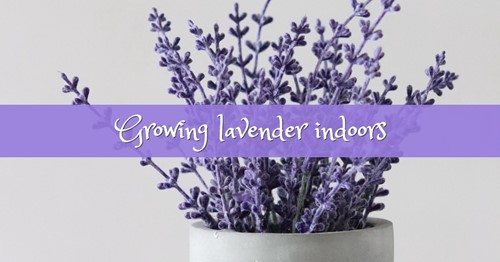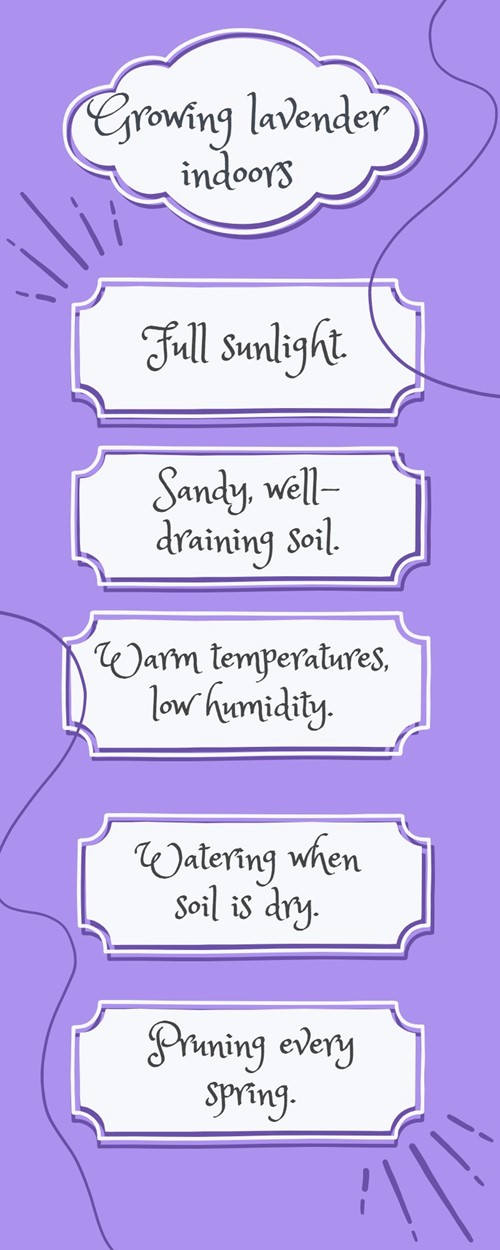Email: [email protected]

Learning how lavender grows can be your ticket to a calming and fragrant home. While lavender is frequently planted outdoors, it can also grow successfully in containers inside. If you’re interested in growing a lavender plant indoors as a houseplant, here are the most important things to know:
Growing lavender requires plenty of direct sunlight. Lavender plants thrive where they can get at least six hours of full sunlight per day. When growing lavender indoors, place your plant in front of a south-facing window. Otherwise, you may need to move the lavender around to follow the best possible sun exposure.
Lavender plants genuinely like “poor” quality soil without any organic matter. Lavender likes to have well-drained soil that’s more sandy than soft. This makes normal indoor potting mix perfectly fine for growing lavender, especially formulas meant for cacti and succulents. You can always add sand or other amendments to improve drainage.
Lavender plants typically grow best in hot, dry environments. When growing it indoors, this means you’ll want to keep it somewhere temperatures are consistently high but with plenty of airflow.
Too much humidity is more of a risk than lower temperatures, however; keep your lavender somewhere with good air circulation and out of steamy areas like bathrooms and kitchens.
Because too much moisture can cause problems for lavender plants, it’s best to water only when the soil feels dry. You can use a moisture meter to test below the surface to ensure the soil is draining properly.
The only exception to this is when the plant is brand new and first becoming established: during the first growing season, water frequently instead of letting the soil dry out too long in between.
Lavender flowers and buds will grow naturally as long as the soil is sufficiently lacking in organic matter. Adding fertilizer or compost will instead encourage the plant to focus energy on its gray green foliage and structure rather than blooms. For the best lavender flowers, prune every spring to encourage new buds to form.

If you want to plant lavender and enjoy its aromatic blooms inside your home, following these tips will help you achieve your goals. With the right balance of warmth, light and well drained soil, you can grow lavender in containers just as well as outside in your garden.

Holder Home Team
I am licensed in both Massachusetts & New Hampshire and Judy takes care of the creative part of things and together we are experts in this local area, we bring a wealth of knowledge and expertise about buying and selling real estate here. It's not the same everywhere, so you need someone you can trust for up-to-date information. We are eager to serve you. Here are some of the things we can do for you:
Find Your Next Home
You need someone who knows this area inside and out! We can work with you to find the right home at the right price for you, including all the neighborhood amenities that matter - not to mention the essential criteria you have for your ideal home
Sell a Home
When it's time to move, you need someone who will advertise your home, show to prospective buyers, negotiate the purchase contract, arrange financing, oversee the inspections, handle all necessary paperwork and supervise the closing. We can take care of everything you need, from start to close.
Consult on Home Selling Tactics
Oftentimes buyers don't visualize living in your home the way you do. We can make your home attractive to its ideal audience - which can help you get top dollar. Things like staging the home, making repairs or minor improvements, or even simply painting the walls can be the difference between a home resting on the market and one that's sold fast.